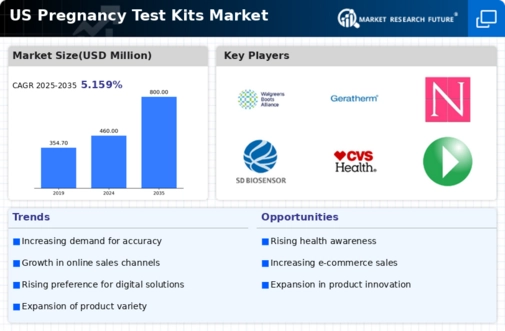Growing Awareness of Reproductive Health
The increasing awareness surrounding reproductive health is a pivotal driver for the pregnancy test-kits market. Educational campaigns and health initiatives have contributed to a heightened understanding of fertility and family planning. As individuals become more informed about their reproductive health, the demand for pregnancy test kits is likely to rise. In the US, surveys indicate that approximately 70% of women aged 18-34 are aware of the various types of pregnancy tests available. This awareness not only encourages early testing but also promotes the use of reliable products, thereby enhancing the overall market for pregnancy test kits.
Increased Accessibility and Availability
The accessibility and availability of pregnancy test kits are crucial factors driving the market. With the proliferation of retail outlets, pharmacies, and online platforms, consumers can easily obtain these products. In the US, the number of retail pharmacies has increased by 5% over the past year, facilitating greater access to pregnancy test kits. Additionally, e-commerce platforms have made it possible for consumers to purchase these kits discreetly, further enhancing their availability. This trend is likely to continue, as convenience remains a key consideration for consumers in the pregnancy test-kits market.
Rising Demand for Home Testing Solutions
The growing preference for home testing solutions is a significant driver for the pregnancy test-kits market. Many consumers favor the privacy and convenience of testing at home rather than visiting a healthcare provider. This trend is particularly pronounced among younger demographics, who value autonomy in managing their reproductive health. Market data suggests that home testing solutions account for over 60% of the total sales in the pregnancy test-kits market. As societal norms shift towards self-care and personal health management, the demand for home testing kits is expected to continue its upward trajectory.
Technological Advancements in Testing Methods
Technological innovations in testing methods are significantly influencing the pregnancy test-kits market. The introduction of digital and app-integrated tests has transformed the user experience, making it more convenient and accurate. For instance, some modern kits now offer results that can be interpreted via smartphone applications, providing users with additional insights. The market has seen a growth rate of approximately 15% in the adoption of these advanced testing methods. As technology continues to evolve, it is expected that the pregnancy test-kits market will expand further, catering to a tech-savvy consumer base.
Influence of Social Media and Online Communities
The influence of social media and online communities plays a notable role in shaping consumer behavior within the pregnancy test-kits market. Platforms such as Instagram and TikTok have become vital channels for sharing personal experiences and product recommendations. This trend has led to increased visibility for various brands and products, driving consumer interest and engagement. Approximately 40% of consumers report that social media influences their purchasing decisions regarding pregnancy test kits. As online communities continue to grow, their impact on the market is likely to intensify, fostering a culture of sharing and support among users.





















Leave a Comment